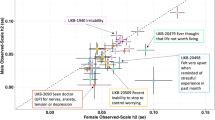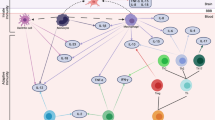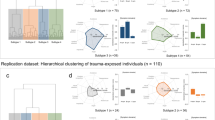Abstract
Despite extensive research on sex/gender differences in posttraumatic stress disorder (PTSD), underlying mechanisms are still not fully understood. Here we present a systematic overview of three sex/gender-related risk pathways. We assessed 16 risk factors as well as 3 month PTSD severity in a prospective cohort study (n = 2924) of acutely traumatized individuals and investigated potential mediators in the pathway between sex assigned at birth and PTSD severity using multiple mediation analysis with regularization. Six risk factors were more prevalent/severe in women, and none was more pronounced in men. Analyses showed that acute stress disorder, neuroticism, lifetime sexual assault exposure, anxiety sensitivity and pretrauma anxiety symptoms fully mediated and uniquely contributed to the relationship between sex assigned at birth and PTSD severity. Our results demonstrate different risk mechanisms for women and men. Such knowledge can inform targeted interventions. Our systematic approach to differential risk pathways can be transferred to other mental disorders to guide sex- and gender-sensitive mental health research.
This is a preview of subscription content, access via your institution
Access options
Subscribe to this journal
Receive 12 digital issues and online access to articles
¥9,000 per year
only ¥750 per issue
Buy this article
- Purchase on SpringerLink
- Instant access to full article PDF
Prices may be subject to local taxes which are calculated during checkout



Similar content being viewed by others
Data availability
Data and/or research tools used in the preparation of this manuscript were obtained from the NDA. The NDA is a collaborative informatics system created by the National Institutes of Health to provide a national resource to support and accelerate research in mental health. Dataset identifier(s) at the NDA Digital Object identifier via https://doi.org/10.15154/c01s-jy79 (ref. 55). This manuscript reflects the views of the authors and may not reflect the opinions or views of the National Institutes of Health (NIH) or of the submitters submitting original data to NDA.
Code Availability
An R-based html markup document, which reproduces our analyses and results, is publicly available in a public OSF repository at https://osf.io/v3euk/ (ref. 54).
References
McCall-Hosenfeld, J. S., Mukherjee, S. & Lehman, E. B. The prevalence and correlates of lifetime psychiatric disorders and trauma exposures in urban and rural settings: results from the National Comorbidity Survey Replication (NCS-R). PLoS ONE 9, e112416 (2014).
Seedat, S. et al. Cross-national associations between gender and mental disorders in the World Health Organization world mental health surveys. Arch. Gen. Psychiatry 66, 785–795 (2009).
Haering, S. et al. Higher risk—less data: challenges to sex and gender considerations in trauma research. Journal of Psychopathology and Clinical Science (in the press).
Kessler, R. C., Sonnega, A., Bromet, E. J., Hughes, M. & Nelson, C. Posttraumatic stress disorder in the National Comorbidity Survey. Arch. Gen. Psychiatry 52, 1048–1060 (1995).
Tolin, D. F. & Foa, E. B. Sex differences in trauma and posttraumatic stress disorder: a quantitative review of 25 years of research. Psychol. Bull. 132, 959–992 (2006).
Christiansen, D. M., McCarthy, M. M. & Seeman, M. V. Where sex meets gender: how sex and gender come together to cause sex differences in mental illness. Front. Psychiatry 13, 856436 (2022).
Rechlin, R. K., Splinter, T. F. L., Hodges, T. E., Albert, A. Y. & Galea, L. A. M. An analysis of neuroscience and psychiatry papers published from 2009 and 2019 outlines opportunities for increasing discovery of sex differences. Nat. Commun. 13, 2137 (2022).
Schiebinger, L. & Schraudner, M. Interdisciplinary approaches to achieving gendered innovations in science, medicine, and engineering. Interdiscip. Sci. Rev. 36, 154–167 (2011).
Tannenbaum, C., Ellis, R. P., Eyssel, F., Zou, J. & Schiebinger, L. Sex and gender analysis improves science and engineering. Nature 575, 137–146 (2019).
Duffy, K. A. & Epperson, C. N. Evaluating the evidence for sex differences: a scoping review of human neuroimaging in psychopharmacology research. Neuropsychopharmacology 47, 430–443 (2022).
Garcia-Sifuentes, Y. & Maney, D. L. Reporting and misreporting of sex differences in the biological sciences. eLife 10, e70817 (2021).
Haering, S. et al. Sex-dependent differences in vulnerability to early risk factors for posttraumatic stress disorder: Results from the AURORA study. Preprint at Open Science Framework https://osf.io/57vjw (2023).
Stranges, T. N., Namchuk, A. B., Splinter, T. F. L, Moore, K. N., & Galea, L. A. Are we moving the dial? Canadian health research funding trends for women’s health, 2S/LGBTQ + health, sex, or gender considerations. Biol. Sex Differ. 14, 40 (2023).
Becker, J. B. & Koob, G. F. Sex differences in animal models: focus on addiction. Pharmacol. Rev. 68, 242–263 (2016).
Christiansen, D. M. Sex differences in PTSD: mediation and moderation effects. in Comprehensive Guide to Post-Traumatic Stress Disorders, Ch. 82 (eds Martin, C. R., Preedy, V. R. & Patel, V. B.) 1465–1481 (Springer, 2016).
Goldstein, J. M., Cherkerzian, S., Tsuang, M. T. & Petryshen, T. L. Sex differences in the genetic risk for schizophrenia: history of the evidence for sex-specific and sex-dependent effects. Am. J. Med. Genet. 162, 698–710 (2013).
McKenzie-McHarg, K. et al. Post-traumatic stress disorder following childbirth: an update of current issues and recommendations for future research. J Reprod. Infant Psychol. 33, 219–237 (2015).
Bryant, R. A. et al. The association between menstrual cycle and traumatic memories. J. Affect. Disord. 131, 398–401 (2011).
Gibson, C. J. et al. Associations of intimate partner violence, sexual assault, and posttraumatic stress disorder with menopause symptoms among midlife and older women. JAMA Intern. Med. 179, 80–87 (2019).
Ravi, M., Stevens, J. S. & Michopoulos, V. Neuroendocrine pathways underlying risk and resilience to PTSD in women. Front. Neuroendocrinol. 55, 100790 (2019).
Ravi, M., Bernabe, B. & Michopoulos, V. Stress-related mental health disorders and inflammation in pregnancy: the current landscape and the need for further investigation. Front. Psychiatry 13, 868936 (2022).
Rowland, G. E. et al. Distinctive impacts of sexual trauma versus non-sexual trauma on PTSD profiles in highly trauma-exposed, Black women. J. Affect. Disord. 317, 329–338 (2022).
Ahern, J. et al. Gender, social support, and posttraumatic stress in postwar Kosovo. J. Nerv. Ment. Dis. 192, 762–770 (2004).
Andrews, B., Brewin, C. R. & Rose, S. Gender, social support, and PTSD in victims of violent crime. Journal of Traumatic Stress 16, 421–427 (2003).
Christiansen, D. M. & Elklit, A. in Post Traumatic Stress Disorders in a Global Context (ed. Ovuga, E.) 113–142 (InTech, 2012).
Haering, S., Stevens, J. S. & Powers, A. Gender-Based Analysis of PTSD Risk Factors in the AURORA Study (AURORA Executive Committee at the University North Carolina, 2022).
Altemus, M., Sarvaiya, N. & Neill Epperson, C. Sex differences in anxiety and depression clinical perspectives. Front. Neuroendocrinol. 35, 320–330 (2014).
Boisclair Demarble, J., Fortin, C., D’Antono, B. & Guay, S. Gender differences in the prediction of acute stress disorder from peritraumatic dissociation and distress among victims of violent crimes. J. Interpers. Violence 35, 1229–1250 (2020).
Bryant, R. A. & Harvey, A. G. Gender differences in the relationship between acute stress disorder and posttraumatic stress disorder following motor vehicle accidents. Aust. N. Z. J. Psychiatry 37, 226–229 (2003).
Lippa, R. A. Gender differences in personality and interests: when, where, and why? Gender differences in personality and interests. Soc. Personal. Psychol. Compass 4, 1098–1110 (2010).
Olatunji, B. O. & Wolitzky-Taylor, K. B. Anxiety sensitivity and the anxiety disorders: a meta-analytic review and synthesis. Psychol. Bull. 135, 974–999 (2009).
Christiansen, D. M. & Hansen, M. Accounting for sex differences in PTSD: a multi-variable mediation model. Eur. J. Psychotraumatol. 6, 26068 (2015).
Preacher, K. J. & Hayes, A. F. Asymptotic and resampling strategies for assessing and comparing indirect effects in multiple mediator models. Behav. Res. Methods 40, 879–891 (2008).
Stein, M. B., Walker, J. R. & Forde, D. R. Gender differences in susceptibility to posttraumatic stress disorder. Behav. Res. Ther. 38, 619–628 (2000).
Rowland, G. E. et al. Prior sexual trauma exposure impacts posttraumatic dysfunction and neural circuitry following a recent traumatic event in the AURORA study. Biol. Psychiatry Glob. Open Sci. https://doi.org/10.1016/j.bpsgos.2023.02.004 (2023).
Lilly, M. M., Pole, N., Best, S. R., Metzler, T. & Marmar, C. R. Gender and PTSD: what can we learn from female police officers? J. Anxiety Disord. 23, 767–774 (2009).
Rothbaum, B. O. et al. Early intervention may prevent the development of posttraumatic stress disorder: a randomized pilot civilian study with modified prolonged exposure. Biol. Psychiatry 72, 957–963 (2012).
Schultebraucks, K. et al. Development and validation of a brief screener for posttraumatic stress disorder risk in emergency medical settings. Gen. Hosp. Psychiatry https://doi.org/10.1016/j.genhosppsych.2023.01.012 (2023).
Wright, E. N., Anderson, J., Phillips, K. & Miyamoto, S. Help-seeking and barriers to care in intimate partner sexual violence: a systematic review. Trauma Violence Abuse https://doi.org/10.1177/1524838021998305 (2021).
Lanius, R. A., Brand, B., Vermetten, E., Frewen, P. A. & Spiegel, D. The dissociative subtype of posttraumatic stress disorder: rationale, clinical and neurobiological evidence, and implications: dissociative subtype of PTSD. Depress. Anxiety 29, 701–708 (2012).
Shaw, S. B. et al. Large-scale functional hyperconnectivity patterns in trauma-related dissociation: an rs-fMRI study of PTSD and its dissociative subtype. Nat. Ment. Health 1, 711–721 (2023).
GBD 2019 Mental Disorders Collaborators. Global, regional, and national burden of 12 mental disorders in 204 countries and territories, 1990–2019: a systematic analysis for the Global Burden of Disease Study 2019. Lancet Psychiatry 9, 137–150 (2022).
McLean, S. A. et al. The AURORA Study: a longitudinal, multimodal library of brain biology and function after traumatic stress exposure. Mol. Psychiatry 25, 283–296 (2020).
Diagnostic and Statistical Manual of Mental Disorders: DSM-5 (American Psychiatric Association, 2013).
Cella, D. et al. The Patient-Reported Outcomes Measurement Information System (PROMIS) developed and tested its first wave of adult self-reported health outcome item banks: 2005–2008. J. Clin. Epidemiol. 63, 1179–1194 (2010).
Pilkonis, P. A. et al. Item banks for measuring emotional distress from the Patient-Reported Outcomes Measurement Information System (PROMIS): depression, anxiety, and anger. Assessment 18, 263–283 (2011).
John, O., Naumann, L. & Soto, C. in Handbook of Personality: Theory and Research (eds John, O., Robins, R. & Pervin, L.) 114–158 (The Guilford Press, 2008).
Gray, M. J., Litz, B. T., Hsu, J. L. & Lombardo, T. W. Psychometric properties of the life events checklist. Assessment 11, 330–341 (2004).
Weathers, F. W., Blake, D., Schnurr, P. P. & Kaloupek, D. G. The life events checklist for DSM-5 (LEC-5). National Center for Posttraumatic Stress Disorder https://www.ptsd.va.gov/professional/assessment/te-measures/life_events_checklist.asp (2013).
Brunet, A. et al. The peritraumatic distress inventory: a proposed measure of PTSD criterion A2. Am. J. Psychiatry 158, 1480–1485 (2001).
Weathers, F. W. et al. The PTSD Checklist for DSM-5. National Center for Posttraumatic Stress Disorder https://www.ptsd.va.gov/professional/assessment/adult-sr/ptsd-checklist.asp (2013).
Dalenberg, C. & Carlson, E. Severity of dissociative symptoms—adult (Brief Dissociative Experiences Scale (DES-B)—modified). American Psychiatric Association https://www.psychiatry.org/psychiatrists/practice/dsm/educational-resources/assessment-measures (2010).
Serang, S., Jacobucci, R., Brimhall, K. C. & Grimm, K. J. Exploratory mediation analysis via regularization. Struct. Equ. Modeling 24, 733–744 (2017).
Haering, S., Stevens, J., Powers, A. Analysis code for 'Disentangling sex differences in PTSD risk factors' Open Science Framework https://osf.io/v3euk/ (2023).
National Institute of Mental Health Data Archive, https://doi.org/10.15154/c01s-jy79 (2024).
Acknowledgements
AURORA is supported by grant U01MH110925 from the National Institute of Mental Health (NIMH) to S.A.M, R.C.K., K.C.K. and K.J.R., the US Army Medical Research and Material Command, the One Mind Foundation and The Mayday Fund. Verily Life Sciences and Mindstrong Health provided some of the hardware and software used to perform study assessments. S.H.’s time is supported by a PhD scholarship of ‘Stiftung der Deutschen Wirtschaft’ (to S.H.). The funding sources had no role in the design and conduct of the study; collection, management, analysis and interpretation of the data; preparation, review or approval of the manuscript; and decision to submit the manuscript for publication. The authors thank A. Williams, X. Yao and the other members of the University of North Carolina Institute for Trauma Recovery for their efforts and aide in this research. We also thank the research staff at McLean Hospital, Emory University, Temple University and Wayne State University for their efforts and aide. We further express our gratitude to the participants and their families for their willingness to participate in this research. The investigators wish to thank the trauma survivors participating in the AURORA study. Their time and effort during a challenging period of their lives make our efforts to improve recovery for future trauma survivors possible. This project was supported by the NIMH under U01MH110925, the US Army MRMC, One Mind and The Mayday Fund. The content is solely responsibility of the authors and does not necessarily represent the official views of any of the funders. Verily Life Sciences and Mindstrong Health provided some of the hardware and software used to perform study assessments. The Many Brains Project provided software for neurocognitive assessments.
Author information
Authors and Affiliations
Contributions
S.A.M., R.C.K., K.C.K., S.H., A.P., J.S.S., A.V.S., S.D.L. and V.M. conceptualized the study. S.L.H., F.L.B., X.A., J.S.S., T.C.N., G.D.C., S.D.L., L.T.G., S.L.R., S.A.M., R.C.K. and K.C.K. performed the methodology. Formal analysis was done by S.H., A.P., J.S.S. S.L.H., F.L.B., X.A., J.S.S., T.C.N., G.D.C., S.D.L., L.T.G., S.L.R., J.P.H., A.B.S., P.I.M.Jr, P.L.H., S.S., C.W.J., B.E.P., R.A.S., N.T.G., L.A.H., J.L.P., M.J.S., C.P., D.A.P., R.C.M., R.M.D., N.K.R., B.J.O., L.D.S., S.E.B., S.A.M., R.C.K. and K.C.K. performed the investigation. S.L.H., F.L.B., X.A., J.S.S., T.C.N., G.D.C., S.D.L., L.T.G., S.L.R., J.P.H., A.B.S., P.I.M.Jr, P.L.H., S.S., C.W.J., B.E.P., R.A.S., N.T.G., L.A.H., J.L.P., M.J.S., C.P., D.A.P., R.C.M., R.M.D., N.K.R., B.J.O., L.D.S., S.E.B., S.A.M., R.C.K. and K.C.K. collected resources. The data curation was done by S.L.H., F.L.B., X.A., J.S.S., T.C.N., G.D.C., S.D.L., L.T.G., S.L.R., S.A.M., R.C.K. and K.C.K. Writing—original draft—was done by S.H., A.P. and J.S.S. Writing—review and editing—was done by A.V.S., S.D.L., V.M., S.L.H., F.L.B., X.A., T.C.N., G.D.C., L.T.G., S.L.R., J.P.H., A.B.S., C.L., P.I.M.Jr, P.L.H., S.S., C.W.J., B.E.P., R.A.S., N.T.G., L.A.H., J.L.P., M.J.S., C.P., D.A.P., R.C.M., R.M.D., N.K.R., B.J.O., L.D.S., S.E.B., S.E.H. S.A.M., R.C.K., K.C.K., J.S.S. and A.P. Visualization was done by S.H., A.P. and J.S.S. S.A.M., R.C.K., K.C.K., S.H., J.S.S. and A.P. supervised the study. Project administration was done by S.L.H., F.L.B., J.S.S., J.P.H., A.B.S., P.I.M.Jr, P.L.H., S.S., C.W.J., B.E.P., R.A.S., N.T.G., L.A.H., J.L.P., M.J.S., C.P., D.A.P., R.C.M., R.M.D, N.K.R., B.J.O., L.D.S., S.E.B., S.A.M., R.C.K. and K.C.K. Funding acquisition was done by S.A.M., R.C.K. and K.C.K. All authors revised the paper critically for important intellectual context and approved the final manuscript.
Corresponding author
Ethics declarations
Competing interests
T.C.N. has received research support from NIH, VA and Rainwater Charitable Foundation and consulting income from Jazz Pharmaceuticals. In the last 3 years, G.D.C. has received research funding from the NSF, NIH and LifeBell AI and unrestricted donations from AliveCor Inc., Amazon Research, the Center for Discovery, the Gates Foundation, Google, the Gordon and Betty Moore Foundation, MathWorks, Microsoft Research, Nextsense Inc., One Mind Foundation, the Rett Research Foundation and Samsung Research. G.D.C. has financial interest in AliveCor Inc. and Nextsense Inc. He also is the CTO of MindChild Medical and CSO of LifeBell AI and has ownership in both companies. These relationships are unconnected to the current work. L.T.G. receives funding from the National Institute of Mental Health (R01 MH121617) and is on the board of the Many Brains Project. L.T.G.’s family also has equity in Intelerad Medical Systems, Inc. S.L.R. reports grants from NIH during the conduct of the study; personal fees from the Society of Biological Psychiatry paid role as secretary, other from Oxford University Press royalties, other from the American Psychiatric Publishing Inc. royalties, other from the Veterans Administration per diem for oversight committee and other from Community Psychiatry/Mindpath Health paid board service, including equity outside the submitted work; other from National Association of Behavioral Healthcare for paid Board service; other from Springer Publishing royalties; and Leadership roles on Board or Council for Society of Biological Psychiatry, Anxiety and Depression Association of America and National Network of Depression Centers. C.W.J. has no competing interests related to this work, though he has been an investigator on studies funded by AstraZeneca, Vapotherm, Abbott and Ophirex. S.E.H. has no competing interest related to this work, though in the last 3 years he has received research funding from Aptinyx and Arbor Medical Innovations and consulting payments from Indiana University and Memorial Sloan Kettering Cancer Center. S.A.M. served as a consultant for Walter Reed Army Institute for Research and for Arbor Medical Innovations. In the past 3 years, R.C.K. was a consultant for Cambridge Health Alliance, Canandaigua Veterans Administration Medical Center, Holmusk, Partners Healthcare, Inc., RallyPoint Networks, Inc. and Sage Therapeutics. He has stock options in Cerebral Inc., Mirah, PYM and Roga Sciences. K.C.K.’s research has been supported by the Robert Wood Johnson Foundation, the Kaiser Family Foundation, the Harvard Center on the Developing Child, Stanley Center for Psychiatric Research at the Broad Institute of MIT and Harvard, the National Institutes of Health, One Mind, the Anonymous Foundation and Cohen Veterans Bioscience. She has been a paid consultant for Baker Hostetler, Discovery Vitality and the Department of Justice. She has been a paid external reviewer for the Chan Zuckerberg Foundation, the University of Cape Town and Capita Ireland. She has had paid speaking engagements in the last 3 years with the American Psychological Association and European Central Bank. Sigmund Freud University—Milan, Cambridge Health Alliance and Coverys. She receives royalties from Guilford Press and Oxford University Press. The remaining authors declare no competing interests.
Peer review
Peer review information
Nature Mental Health thanks Hannah Schumm, Saurabh Shaw and the other, anonymous, reviewers for their contribution to the peer review of this work.
Additional information
Publisher’s note Springer Nature remains neutral with regard to jurisdictional claims in published maps and institutional affiliations.
Extended data
Extended Data Fig. 1 Distribution of PTSD symptoms 3-months post-trauma by sex.
Density and boxplot for the distribution of 3-month PTSD symptoms as measured by the PCL-5, including n = 1818 women and n = 1124 men. The boxplot indicates the median as well as the 25th and 75th percentiles. Whiskers indicate 1.5 times the inter-quartile range.
Supplementary information
Supplementary Information
Supplementary information on measures included in this study. Supplementary Tables 1–5.
Rights and permissions
About this article
Cite this article
Haering, S., Seligowski, A.V., Linnstaedt, S.D. et al. Disentangling sex differences in PTSD risk factors. Nat. Mental Health 2, 605–615 (2024). https://doi.org/10.1038/s44220-024-00236-y
Received:
Accepted:
Published:
Issue Date:
DOI: https://doi.org/10.1038/s44220-024-00236-y



